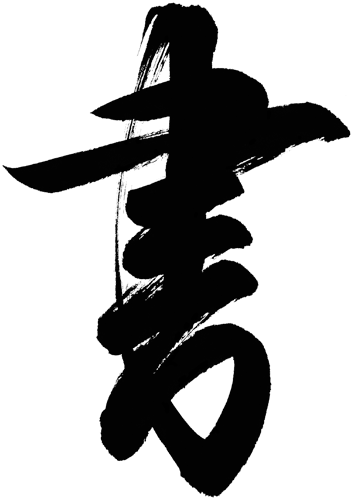I just visited Mainichi Shodo Exhibition in Roppongi. I took a lot of pictures which I’ll post tomorrow. By the way, organizers gave me nice brochure in English with some basic information about Japanese calligraphy. I thought you might like to read it. Scan of the brochure
Difference between Shodo and Shuji
Japanese calligraphy (“Shodo”) is an artistic form of written expression. There are two ways to translate the word “calligraphy” to Japanese: “Shuji” and “Shodo”. The word “Shuji” consists of two characters: “Shu” – to learn, and “Ji” – characters; it can be translated as “penmanship”. The word “Shodo” is also composed from two characters, but their meanings are different: “Sho” – to write, and “Do” – a way. We can translate “Shodo” roughly as “calligraphy”. A word-for-word translation, however, would be “the way of writing”. The character for way (in Japanese reading “Michi”, in Sino-Japanese reading “Do”) is used very frequently in various compound words. It occurs in the names of a number of Japanese arts: the tea ceremony “Sado” (“Chado”), the art of flower arrangement “Kado”, the martial art “Judo”, to name a few. For Westerners, the two words – penmanship and calligraphy – do not carry the same important distinction as their Japanese counterparts. “Shuji” is the neat handwriting taught at primary schools, with balanced, equally sized characters composed of even strokes. “Shodo” is the artistic expression of a calligrapher, who does not strive for even lines and neat characters. He chooses an appropriate style, writes characters in a way that corresponds to the topic; his work is personal and distinctive, making the characters come to life. From the point of view of “Shodo” there is nothing worse than a calligraphy indistinguishable from the geometrically perfect characters printed out of a computer. Despite the technological advancements, one's original handwritten expression is still highly important to the Japanese. It is for instance unthinkable for a job applicant to bring a computer printed curriculum vitae to an interview. It has to be written exclusively in one's own hand and composing it is a troubling experience for many. Everyone knows well that a name of a prestigious university does not suffice, the curriculum vitae has to be written in graceful characters whose appearance speaks for the author. In Japan, calligraphy is pervasive. It might appear on a label of a sake bottle, a signboard of a restaurant luring customers, or in logos of the latest high-tech products. That said, young Japanese people do not have time to practice calligraphy nowadays, they only use a brush once a year for the New Year's wishes. Nonetheless, “Shodo” hasn't lost any of its importance and is still a highly-prized skill, fully comparable with the arts of music, theatre or painting.
The roots of Japanese calligraphy can be traced to China, where the character-based script, known as “Kanji” in Japanese, was invented. The original character-based writing system was created about 3500 years ago for religious purposes, serving not for communication between humans, but for communication with gods. Pictographs were etched on animal bones and tortoise shells. Today, calligraphy is done using a brush „Fude“, made usually from animal hair, and the ink “Sumi”. Even though Japanese calligraphy has its distinctive history, the similarity with Chinese calligraphy is considerable, making them difficult to tell apart for an untrained eye. Subtleties aside, the main difference is in the characters themselves. The Chinese language employs a much greater number of characters, often simplified over the course of time. A work of a Chinese calligrapher composed of traditional characters might look exactly the same as a Japanese calligraphy though. A peculiarity that sets Japanese writing apart from Chinese writing is “Hiragana” and “Katakana”: two syllabary scripts derived from the characters (“Kanji”), but clearly different in appearance. The usage of “Kana”, as both syllabaries are commonly called, is unique to Japanese calligraphy.
